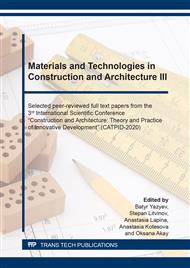p.72
p.79
p.85
p.92
p.97
p.103
p.109
p.116
p.123
Mass Compositions Calculation on the Basis of Argillites at Ceramic Tiles Production
Abstract:
The results of selection and principles of calculating the ceramic masses composition for the clinker tiles’ production from argillites taking into account the raw materials’ characteristics are presented. The positive properties of argillites, as well as the properties that do not allow the tiles’ production of by stamping, which is traditional for these products’ manufacturing, are noted. Having low sensitivity to drying, low air shrinkage, high strength of the calcined shard, while being fusible sintering raw materials, argillites are low plastic and have insufficient bonding during molding, which indicates the need for corrective additives. In this work, the task to select the composition of ceramic masses to increase the plasticity of argillites while maintaining the positive properties of the main raw material was set. The authors proposed the use of siliceous clays as a corrective additive. An integrated approach was applied in calculating ceramic masses by grain composition and chemical and mineralogical indicators. Based on the research of A.I. Avgustinik, the oxide content Ca, Mg, Fe, Na, K and attitude Al2O3/SiO2 was taken into account. In order to obtain the densest packing, when calculating the grain composition, the natural dispersion of siliceous clays and the grain composition of previously prepared argillites were taken into account. The obtained theoretical calculations were tested in practice. Practical results showed that the 15% introduction of siliceous clay with the ceramic mass composition made it possible to obtain clinker tiles with improved physical and mechanical properties.
Info:
Periodical:
Pages:
97-102
Citation:
Online since:
September 2020
Authors:
Keywords:
Price:
Сopyright:
© 2020 Trans Tech Publications Ltd. All Rights Reserved
Share:
Citation:


